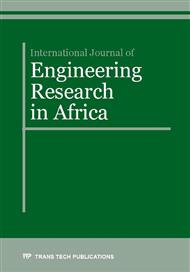[1]
J. Antony, M. Kumar, C. Mandu, Six sigma in small and medium sized UK manufacturing enterprises: some empirical observations. International journal of quality and reliability management. 22 (8), (2005) 860–874.
DOI: 10.1108/02656710510617265
Google Scholar
[2]
J. Doshi, D. Desai, Review of continuous quality improvement methodology – enablers, exertion, benefits for SMEs. International Journal of Quality and Innovation. 2(3), (2014) 245–255.
DOI: 10.1504/ijqi.2014.066357
Google Scholar
[3]
Automotive Industry Action Group (AIAG), Production Part Approval Process (PPAP) - reference manual, 4th edn, (2010) 5-125.
Google Scholar
[4]
Shrotri A.P., Dandekar A.R., PPAP an effective tool for vendor quality management, International Journal of Emerging Technology and Advanced Engineering, 2(4) (2012) 1-12.
Google Scholar
[5]
Krajewski, Lee, Larry Ritzman and Manoj Malthor, Operations Management. Processes and Value Chain. Prentice Hall, New Jersey, (2010).
Google Scholar
[6]
Salomäki, Rauno, Hyödynnä SPC – Suorituskykyiset prosessit. Metalliteollisuuden Kustannus Oy, (1999).
Google Scholar
[7]
J. Doshi, S. Jani, Measurement System Analysis for Quality Improvement Using Gage RandR Study at Company Based Ahmedabad – Manufacturer of Automotive AC Air Duct. Admet ARAI. (2012) 1-7.
Google Scholar
[8]
A.P. Shrotri, A.R. Dandekar, PPAP an effective tool in vendor quality management. International Journal of Emerging Technology and Advanced Engineering, 2(4), (2012) 369-372.
Google Scholar
[9]
N. Belu, A. Ali, N. Khassawneh, Application of Control Plan – PPAP Tool in Automotiive Industry. Production QUAL ITY access to success, 14(136), (2013) 5-12.
Google Scholar
[10]
A.P. Shrotri, A.R. Dandekar, S.B. Khandagale, Essential Requirements of PPAP. International Journal of Technological Exploration and Learning, 3(3), (2014) 502-505.
Google Scholar
[11]
Desai, D. A, Cost of quality in small- and medium-sized enterprises: case of an Indian engineering company, Production Planning and Control – The Management of Operations, 16(1), (2008) 25–34.
DOI: 10.1080/09537280701773336
Google Scholar
[12]
Raisinghani, M., Kaiser, J.G. and Abdulovic, T, Theoretical quality management frameworks in today's business: an automobile industry application, Proceedings of Informing Science and IT Education Conference, (2011) 471–488.
DOI: 10.28945/1473
Google Scholar
[13]
Yan, B. and Makinde, O.D., Impact of continuous improvement on new product development within SMEs in the Western Cape, South Africa, African Journal of Business Management, 5(6), (2011) 2220–2229.
Google Scholar
[14]
Hirsijärvi, Sirkka, Remes, Pirkko and Sajavaara, Paula, Tutki ja kirjoita. Tammi. 464 (2010).
Google Scholar
[15]
R. K Yin, Case Study Research: Design and Methods, 3rd ed., Sage, Thousand Oaks, CA, (2003).
Google Scholar
[16]
C Voss, N Tsikriktsis, M Frohlich, Case research in operations management. International Journal of Operations and Production Management. 22(2), (2002) 195-219.
DOI: 10.1108/01443570210414329
Google Scholar
[17]
J Meredith, Building operations management theory through case and field research. Journal of Operations Management. 16(1), (1998) 441-540.
DOI: 10.1016/s0272-6963(98)00023-0
Google Scholar
[18]
Cooper DR, Schinddler PS, Business research methods. Tata McGraw-Hill. New Delhi (2005).
Google Scholar


